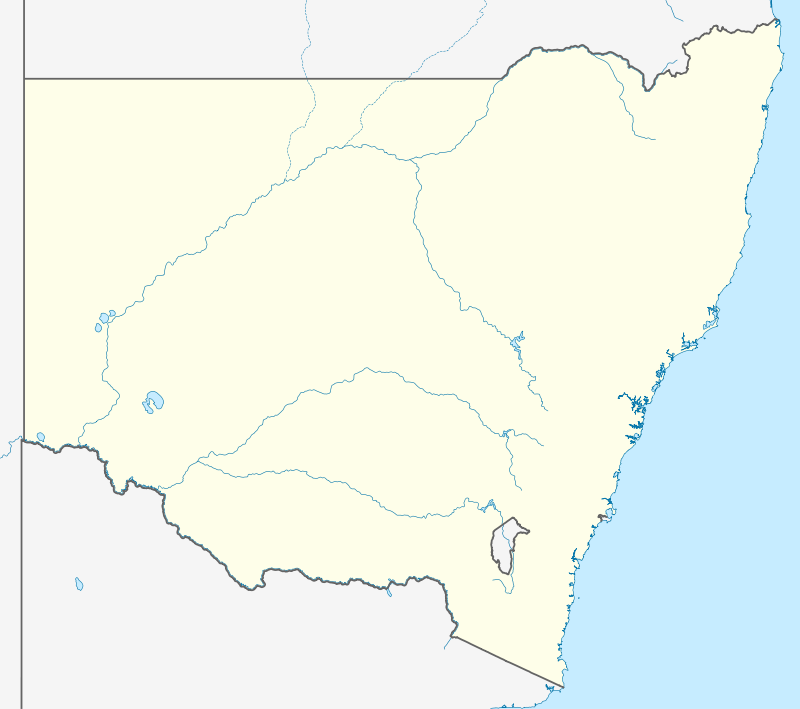HMS Nabberley
HMS Nabberley was a Royal Navy Mobile Naval Operating Air Base (MONAB) at the Royal Australian Air Force (RAAF) base RAAF Bankstown at Bankstown, New South Wales, Australia. HMS Nabberley was also known as MONAB II and Royal Naval Air Station (RNAS) Bankstown.[1]
| HMS Nabberley | |
|---|---|
| Bankstown, New South Wales in Australia | |
 HMS Nabberley Location within New South Wales | |
| Coordinates | 33°55′30″S 150°59′18″E |
| Type | Mobile Naval Operating Air Base (MONAB) |
| Site information | |
| Owner | Australian Ministry of Defence |
| Controlled by | Royal Navy Fleet Air Arm |
| Site history | |
| In use | 1944 – 1946 |
History
Assembled at RNAS Ludham and Royal Navy Air Establishment Risley, Warrington, in October 1944. The duties of HMS Nabberley were changed from that of a MONAB to that of a Receipt and Dispatch Unit shortly after formation causing some administration problems. Due to accommodation issues 600 ratings were based at HMS Gosling, in Warrington, Lancashire. HMS Nabberley commissioned as an independent command on 18 November 1944.[2]
The stores, equipment and vehicles sailed from Gladstone Dock, Liverpool on 20 November upon SS Perthshire (LS 1974) and personnel of MONAB II, in company with elements from HMS Nabthorpe and other units sailed from Liverpool upon RMS Athlone Castle on 22 December 1944 for passage to Australia.[2]
HMS Unicorn carrying an advance party of MONAB II arrived in Sydney on 1 December 1944. The advance party arrived at RAAF Bankstown in Sydney, together with 16 crated aircraft (8 Corsair IIs and 8 Martinet TT.Is) requestioned from the Royal Navy Aircraft Depot at Cochin, India. The aircraft were assembled with RAAF assistance and the first aircraft assembled (Corsair II JT537) was test flown on 18 January 1945.[2]
After the main party arrived in Sydney on 25 January 1945, some proceeded directly to Bankstown, however most were temporarily accommodated Warwick Farm Racecourse (Camp Warwick), a part of HMS Golden Hind, the Royal Navy barracks in Sydney, until accommodation was sorted out.[2]
RAAF Bankstown was officially transferred on a loan basis to Royal Navy on 27 January 1945 and stores and equipment began to arrive at the station. The base was commissioned as HMS Nabberley, RNAS Bankstown on 29 January 1945.[3]
The personnel began assembling crated aircraft and carrying out pre-issue test flights as a Receipt and Dispatch Unit. A total of 2,500 test flights were undertaken during the operation of HMS Nabberley.[3]
Prince Henry, Duke of Gloucester, the Governor-General of Australia, toured the facility on 1 June 1945.[3]
On 23 August 1945 the aircraft from the disbanded 1834 and 1835 squadrons were delivered from HMS Victorious for disposal.[3]
HMS Nabberley, MONAB II, was paid off on 31 March 1946. The airfield returned to RAAF control.[3]
Commanding officers
- Commander E. P. F. Atkinson, 18 November 1944
Units based at HMS Nabberley
- 723 Fleet Requirements Unit (28 February–1 May 1945)
- 724 Naval Air Communications Squadron
- Aircraft Erection Unit
- Aircraft Equipping & Modification Unit
- Aircraft Storage Unit
- Maintenance, Storage & Repair 3, 4, 7 & 8
Squadrons based at HMS Nabberley
- 723 Naval Air Squadron (28 February–1 May 1945) (Martinet TT.I and Corsair II). Redesignated as 723 Fleet Requirements Unit.
- 724 Naval Air Squadron (10 April 1945) (Expediter I and Anson I)
- 1830 Naval Air Squadron (4–24 May 1945) (Corsair II)
- 1833 Naval Air Squadron (4 May 1945 only) (Corsair II)
- 'A' Flight 1701 Naval Air Squadron (24 July–7 August and 15–21 October 1945) (Sea Otter)[3]
Aircraft carriers squadrons disembarked from/embarked to
Satellite airfields
- Nil
References
- G. Drucker (2001). "Index of Fleet Air Arm Air Stations in the Commonwealth 1939-1945". Fleetairarmarchive.net. Archived from the original on 19 September 2008. Retrieved 16 May 2014.
- "MONAB II (page 1)". royalnavyresearcharchive.org.uk. 2014. Retrieved 16 May 2014.
- "MONAB II (page 2)". royalnavyresearcharchive.org.uk. 2014. Retrieved 16 May 2014.